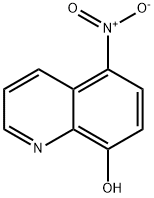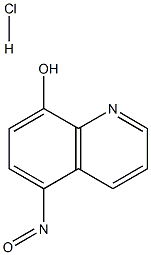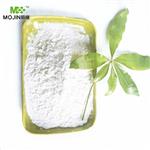Description
Nitroxoline is an 8-hydroxyquinoline that has diverse biological activities, including antibacterial, antiproliferative, and bromodomain interaction-inhibiting properties. Nitroxoline is active against the bacteria
E. coli,
S. aureus,
E. faecalis,
K. pneumoniae, and
P. mirabilis in vitro (MIC
90s = 4, 4, 8, 8, and 8 mg/L, respectively). It also inhibits biofilm formation of certain strains of multidrug-resistant (MDR)
A. baumannii and
P. aeruginosa, as well as methicillin-resistant
S. aureus (MRSA) and
S. epidermidis (MRSE) with minimum biofilm eradication concentration (MBEC) values of 46.9, 1,500, 188, and 125 μM, respectively. Nitroxoline inhibits the growth of human U87 and U251 glioma, A549 lung, and PC3 prostate cancer cells (IC
50s = 50, 6, 38, and 23 μg/ml, respectively).
In vivo, it reduces tumor growth in a PTEN- and KRAS-driven glioma mouse model when administered at a dose of 80 mg/kg per day. Nitroxoline also inhibits the interaction between the first bromodomain of bromodomain-containing protein 4 (BRD4) with acetylated histone H4 with an IC
50 value of 0.98 μM.
Chemical Properties
ochre-yellow to brownish crystalline powder
Uses
5-Nitro-8-hydroxyquinoline is an antimicrobial agent used for the treatment of urinary tract infection. 5-Nitro-8-hydroxyquinoline is also a potent and reversible inhibitor of cathepsin B. 5-Nitro-8-h
ydroxyquinoline has been shown to have anti-cancer activity.
Uses
8-Hydroxy-5-nitroquinoline was used in the synthesis of novel CO
2-soluble 8-hydroxyquinoline chelating agents.
Definition
ChEBI: A monohydroxyquinoline in which the hydroxy group is positioned at C-8 with a nitro group trans to it at C-5.
brand name
5-nitrok;Dovenix;Entercol;Enterocol;Isinok;Nicene;Nikinol;Nikopet;Noxine;Trodax;Uro-coli.
World Health Organization (WHO)
Nitroxoline, a urinary antiseptic, was introduced in the mid-1960s.
By the early 1970s long-term animal studies revealed the development of cataracts
in rats and, although no serious adverse effects had been reported in man, the
drug was withdrawn in at least two countries. Preparations containing nitroxoline remain widely available.
Biochem/physiol Actions
8-Hydroxy-5-nitroquinoline is an effective anti-microbial and anti-cancer agent. It is an effective drug for the treatment of urinary tract infections due to gram negative bacilli.
in vitro
the machnistic study showed that nitroxoline, in the treatment of acute or recurrent urinary tract infections caused by escherichia coli, could be decreased in the presence of mg2+ and mn2+ but not ca2+. moreover, with the divalent metal ions, a shift in the nitroxoline a448 indicated the formation of drug-ion complexes and a clear correlation was observed between the chelating property and antibacterial activity of nitroxolinet. in addition, it was found that the uptake was energy-independent and with biphasic kinetics: a rapid cell association phase and then a slower increase of cell- nitroxoline association [1].
in vivo
previous animal study showed that nitroxoline suspension with tween-80 in a could decrease the tone of the rat and guinea-pig ileum and diminish their peristalsis. moreover, when administered orally in a dose 50 mg/kg to rats, nitroxoline was able to inhibit the agar-, serotonin-, as well as carrageenin-induced edemas of the rat paws without affecting the response to subplantar histamine injection [2].
References
[1] pelletier c,prognon p,bourlioux p. roles of divalent cations and ph in mechanism of action of nitroxoline against escherichia coli strains. antimicrob agents chemother.1995 mar;39(3):707-13.
[2] zaks as,zil'ber al,kapitonenko ta. spasmolytic and anti-inflammatory activity of 8-hydroxyquinolines. farmakol toksikol.1984 sep-oct;47(5):44-7.
[3] lambert-zechovsky n,lévêque b,bingen e,pillion g,chapelle j,mathieu h. clinical study and effect of nitroxoline on fecal flora in childrenpathol biol (paris).1987 may;35(5):669-72.





